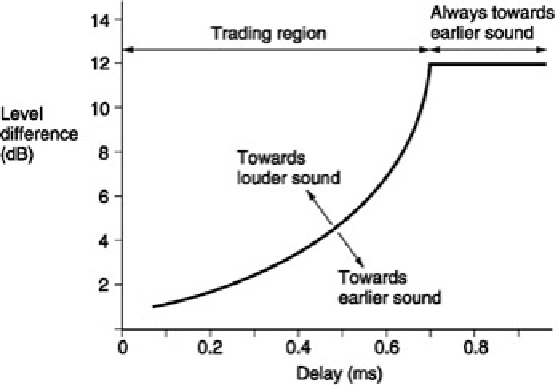Information Technology Reference
In-Depth Information
Layer II and Dolby AC-3 coders even though their internal workings are quite different. This is not surprising
because both are probably based on the same psychoacoustic masking model.
Figure 4.47:
Time-intensity trading occurs within the inter-aural delay period.
MPEG Layer III fares quite badly in stereo because the bit rate is lower. Transient material has a peculiar effect
whereby the ambience would come and go according to the entropy of the dominant source. A percussive note
would narrow the sound stage and appear dry but afterwards the reverb level would come back up.
The effects are not subtle and do not require 'golden ears' or special source material. The author has successfully
demonstrated these effects under conference conditions.
All these effects disappear when the signals to the speakers are added to make mono as this prevents attentional
selectivity and unmasking cannot occur. The above compression artifacts are less obvious or even absent when
poor-quality loudspeakers are used. Loudspeakers are part of the communication channel and have an information
capacity, both timbral and spatial. If the quality of the loudspeaker is poor, it may remove more information from the
signal than the preceding compressor and coding artifacts will not be revealed. The precedence effect allows the
listener to locate the source of a sound by concentrating on the first version of the sound and rejecting later
versions. Versions which may arrive from elsewhere simply add to the perceived loudness but do not change the
perceived location of the source. The precedence effect can only reject reverberant sounds which arrive after the
inter-aural delay. When reflections arrive within the inter-aural delay of about 700 s the precedence effect breaks
down and the perceived direction can be pulled away from that of the first arriving source by an increase in level.
Figure 4.47
shows that this area is known as the time-intensity trading region.
Once the maximum inter-aural delay is exceeded, the hearing mechanism knows that the time difference must be
due to reverberation and the trading ceases to change with level.
Unfortunately reflections with delays of the order of 700 s are exactly what are provided by the traditional
rectangular loudspeaker with flat sides and sharp corners. The discontinuities between the panels cause
impedance changes which act as acoustic reflectors. The loudspeaker becomes a multiple source producing an
array of signals within the time- intensity trading region and instead of acting as a point source the loudspeaker
becomes a distributed source.
Figure 4.48
shows that when a loudspeaker is a distributed source, it cannot create a point image. Instead the
image is also distributed, an effect known as smear. Note that the point sources have spread so that there are
almost no gaps between them, effectively masking the ambience. If a compressor removes it the effect cannot be
heard. It may erroneously be assumed that the compressor is transparent when in fact it is not.
Figure 4.48:
A loudspeaker which is a distributed source cannot produce a point stereo image; only a spatially
spread or smeared image.


